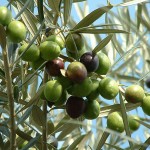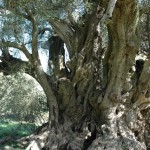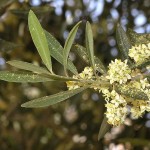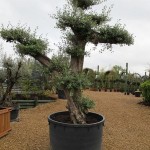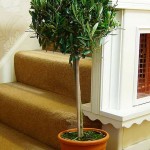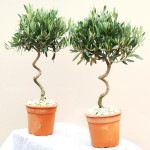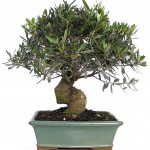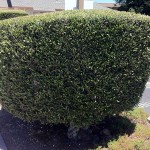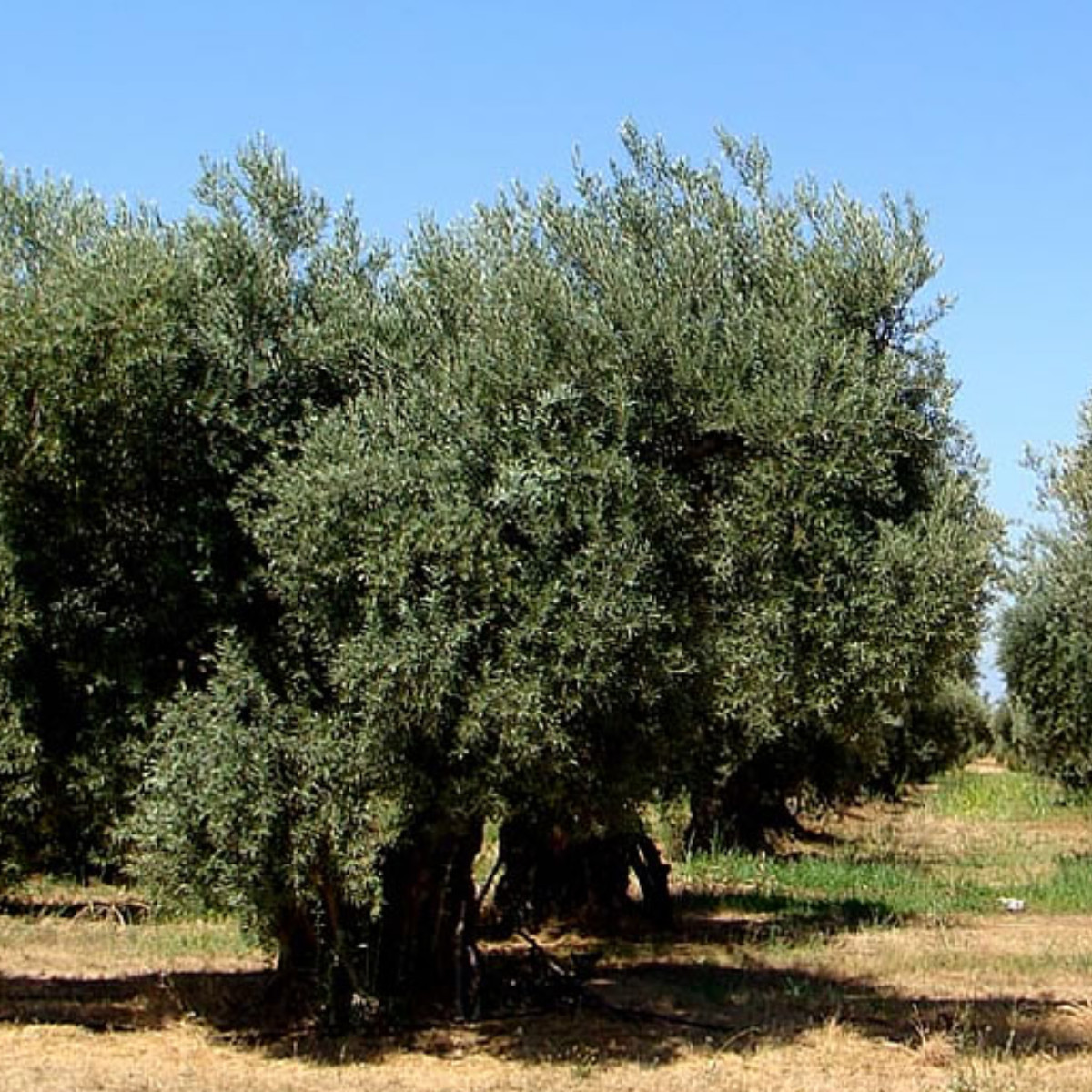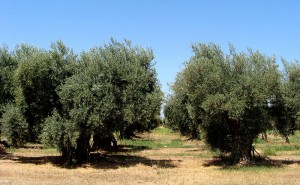Family: Oleaceae
Distribution and habitat: Olea europaea is a small tree native to the coastal areas of the eastern Mediterranean Basin as well as the Levant, northern Saudi Arabia, northern Iraq and northern Iran at the south of the Caspian Sea. Its fruit, also called the olive, is of major agricultural importance in the Mediterranean region as the source of olive oil. Olea europaea is one of the oldest known cultivated plant and olives are one of the most extensively cultivated fruit crops in the world.
Since its first domestication, Olea europaea has been spreading back to the wild from planted groves. Its original wild populations in southern Europe have been largely swamped by feral plants. But in some parts of the world where it has been introduced, most notably South Australia, the Olea europaea tree has become a major woody weed that displaces native vegetation. In South Australia, its seeds are spread by the introduced red fox and by many bird species, including the European starling and the native emu, into woodlands, where they germinate and eventually form a dense canopy that prevents regeneration of native trees. As the climate of South Australia is very dry and bushfire prone, the oil rich feral olive tree substantially increases the fire hazard of native sclerophyll woodlands.
Description: Olea europaea is an evergreen tree which typically reach about 7-9m (25-30 feet) tall with a naturally slight weeping habit. When the trees are young, they have a smooth grey bark, but as they age the trunks become increasingly gnarly looking. The elliptical to lanceolate leaves are grey-green above and silvery beneath, up to 8cm (3 inch) long. To be able to survive in a hot and dry climate, the leaves have a protective coating and are hairy undersides, an adaptation that slows down the transpiration process.
Olea europaea is a hermaphrodite tree and blooming occur in the spring. The small white, feathery flowers, with a four-lobed calyx and a four-lobed corolla, two stamens and bifid stigma are borne generally on the previous year's wood, in racemes springing from the axils of the leaves. The flowers produce pollen and are pollinated by wind, though, most olive varieties are self-fertile. The small, white, fragrant flowers are followed by fruits. The fruit is a small drupe 12.5 cm (0.401 inch) long, thinner-fleshed and smaller in wild plants than in orchard cultivars. Olives are harvested in the green to purple stage. Olives ripen through the autumn and into the winter. Olea europaea drupe contains a seed commonly referred to as a pit, a rock or as a stone.
Trees can produce a crop when they are 6 years old and continue producing a commercial yield for the next 50+ years.
There are Olea europaea trees varieties grown for fruit harvest, for oil production and even fruitless varieties grown just for ornamental proposes.
Culture: Olea europaea trees can live for several centuries and can remain productive for as long if they are pruned correctly and regularly. The plants fruit best on wood that is one year old so any pruning should take this into account.
These trees grow very slowly and over many years the trunk can attain a considerable diameter. Once established, Olea europaea is highly drought-resistant and tolerant of poor, infertile soils.
Flower production depends on a 12-15 week period of diurnally fluctuating temperatures with at least 2 months averaging below 10C (50F). Very dry soil conditions can inhibit flowering. Prolonged cold weather - 7C (45F) can also inhibit fruit production.
Pruning can encourage non-fruiting water-shoots. To produce more fruit, the tree need to be pruned heavily. Also, weighing down or arching the branches may encourage fruiting.
Uncollected olives are staining pavement and can generally create a mess. The fruits not only will stain walkways, but they are harmful to grass and other plants growing underneath them. When planting olive trees that will not be harvested, consider the several varieties of fruitless olives that can be grown successfully. Fruitless varieties are less likely to aggravate allergies and are more desirable for ornamental plantings.
Do not plant Olea europaea tree too close to walls, patios or swimming pools as the root system can sometimes be aggressive.
Location: Olea europaea trees Olive prefer sub-tropical and temperate regions of the world. These trees are native to the Mediterranean, Asia and Africa. They like hot weather and sunny positions without any shade. They need full sun for fruit production, but also need a slight winter chill for the fruit to set. Temperatures below minus 10C (14F) may injure even a mature tree.
Plant them in a sunny, sheltered and well drained site. A south facing position is ideal, however it is not essential as long as there is lot of sunlight and the soil is well drained.
Soil: Olea europaea trees prefer calcareous soils, flourishing best on limestone slopes and crags and coastal climate conditions. These trees will tolerate most soil types from chalky, clay, loamy or sandy, if the soil is well drained. Plant the trees in deep and uniform soil for best results and quick establishment. A well drained soil can be achieved by digging in lots of grit before planting.
In rich soils these trees are predisposed to disease and produce less oil than in poorer soil.
They are not tolerant of saturated soils or lawn conditions, but they tolerate salty air and windy conditions of costal regions.
Mulches help prevent water loss during hot, windy or sunny weather.
Irrigation: In the first year of planting, Olea europaea trees in the ground need to be kept well watered too, however once established they can tolerate some small periods of drought but prefer to be watered occasionally. Water these trees moderately. Soak root zone 1-2 times per month in summer and they will require no watering in winter. Needs excellent drainage and a deep water table for reliable fruiting. Watering from a hose or sprinkler should be done slowly and deeply, not frequently, to avoid shallow root development or root diseases. Allow soil to dry several centimetres deep before irrigating again. When practical, especially in arid climates, use and maintain water-efficient soaker hoses or drip irrigation.
Hedge plantings of Olea europaea should be watered during drought periods to avoid excessive leaf loss.
Olea europaea trees tolerate drought well, thanks to their sturdy and extensive root system.
Fertilise: To help promote new growth, flowering and fruiting, give a feed with a slow release general purpose fertiliser around the base of the tree in spring. In the growing season an occasional feed with a liquid fertiliser is beneficial. Stop feeding the tree in early fall to stop the new growth which could be damaged in winter.
Particularly the hedge plantings will benefit from fertilising during the growing season if they become slow or thin canopied.
Never over fertilise.
Pruning: Olea europaea trees should be regularly pruned to keep them in shape and to promote new growth. The pruning preserves the flower-bearing shoots of the preceding year, while keeping the tree low enough to allow the easy gathering of the fruit. The crop from old trees is sometimes enormous, but they seldom bear well two years in succession and in many cases a large harvest occurs every sixth or seventh season.
A light prune in spring will help shape the tree after the winter by cutting out any dead, damaged or diseased growth. At the same time thin out branches to allow light to get into the centre of the tree and remove any branches that spoil the shape. In summer a heavier prune can be done if required. Olea europaea trees can put a lot of growth on during this time and might need to be kept in check and aerate for good health.
Usually these trees are trained to a single leader. It may need to remove suckers and lower branches. The Olea europaea trees tolerate lopping. If grown as ornamental tree, remove flowering and fruiting branches early to avoid unwanted fruit drop. They can be grown as a hedge or topiary plants.
Thinning of the crop is recommended, reducing the fruit numbers to three or four per 30cm (12 inch) of branch within three weeks of flowering, in order to ensure that the crop will ripen and not drop prematurely.
Container plants: Olea europaea are easy to culture and make great container plants. When grown in container Olea europaea tree can be grown outside of its hardiness zone by providing shelter over winter. These trees are surprisingly hardy; large plants can be hardy to around minus 15C (5F) or lower, as long as the soil is well drained. Mature plants will be evergreen to around this temperature, younger plants are more susceptible to leaf loss if the temperatures are continually very low. They soon start to regain their leaves once the spring has arrived. The potted trees can be over-wintered inside to help retain their leaves.
Container grown trees may need additional summer pruning to keep their size in check. When trees in containers get to about 1.5m (5 feet), pinch out the tips to encourage brancing.
Light: Over-wintered indoors, the potted Olea europaea needs the sunniest position possible, including west. Maximising ventilation and light, help these trees to retain their foliage over winter. Move the plants outdoors in spring in full sun. They will grow well in hot sunny position.
Plants kept indoors are unlikely to flower.
Temperature: In frosting areas, during the winter months, the plants should be moved to a cool room where the night time temperature goes down to 9C (48F).
Water: If planted into a container make sure the Olea europaea tree is well watered during the growing season as the roots cannot search for water like they do in the ground. Special attention require if planted in terracotta as this bakes the soil in summer. Even though these trees are very drought tolerant, water them at least twice a week during the active growth period. Water is restricted to once every 2 weeks during the winter period.
Watch out for the roots of containerised plants becoming waterlogged.
Fertiliser: It is more important to feed container planted trees as the nutrients are soon depleted from the soil after a growing season. Fertilise them monthly with a balanced fertilizer.
Potting and repotting: Olea europaea trees can successfully grow in containers for many years. Use a soil mix consisting of two parts peat moss to two parts loam to one part sand or perlite. Never over-pot this tree and always repot it just to a slightly larger pot every spring.
Propagation: Olea europaea can be propagated by means of air layering, cuttings, grafting, seed or suckers. Worldwide, rooting of cuttings is the most popular method of Olea europaea propagation. However, yields from trees grown from suckers or seeds are poor; they must be budded or grafted onto other specimens to do well.
Softwood: Softwood cuttings root better and are more common than hardwood cuttings. Use one to two years old wood in summer. Take about 5-10cm (2-4 inch) long cuttings with hill saving two pair of leaves and treat them with a rooting hormone, then plant them in pots filled with well aerated and free draining compost: two parts sharp sand and one part general purpose compost. Keep the pots in frames at a constant temperature of 232C (734F) and the relative humidity at 50-70% by spray-mist. They grow rapidly and more than 0.5m (2 feet) long lead stems develop easily in a year. To encourage branching pinch out growing tips on leader. To plant the new plants out in a bed wait till next late spring or summer for best results.
Hardwood: Hardwood cuttings are made from 3-4 year-old wood taken in mid-winter. Leaves are striped off completely and cuttings are rooted over the course a several months. Bottom heat and growth regulator dips improve rooting. Unusually large cuttings will also root. Cuttings with diameters between 15-30cm (6-12 inch) are used sometimes to establish new plantings. They are pruned heavily and mounded with soil throughout winter and rooting takes place prior to summer heat.
Air Layering: A high success rate with air layering can be achieved. Layering in spring through late summer produces masses of roots in about 6-8 weeks. Best potted and overwintered in a cool rooms before planting out in the following summer.
Suckers: Suckers are simply shoots that arise from the trunk or roots and thus are similar to a naturally rooted cutting. They can be removed and planted directly if well-rooted or treated as a softwood cutting if the root system is poor.
Grafting: T-budding and wedge grafting are used for cultivars which root poorly or when rootstock use is warranted. T-budding is done in spring when bark is slipping on rootstocks propagated the previous year from seed or cuttings. Simple wedge or V-grafts can be made in winter or spring. Scions 5-8cm (2-3 inch) long, taken from the central portion of one year shoots, are grafted onto stocks.
Seed - Seeds have a low success rate of only 30%. For home produced seed should be given a period of cold stratification first. Where possible, it is best to sow the seed as soon as it is ripe in a greenhouse in the autumn. Prick out the seedlings into individual pots when they are large enough to handle and grow them on in the greenhouse for at least their first winter, perhaps for their first two or three winters. Plant them out into their permanent positions in early summer and give them some protection from winter cold for at least their first winter outdoors. To facilitate germination, the oily pericarp is first softened by slight rotting or soaked in hot water or in an alkaline solution.
Problems: In general, Olea europaea trees are hardy, although they can suffer from a few insect pests and diseases.
Olea europaea trees are host to a number of diseases caused by viral agents. The olive leaf yellowing associated virus, strawberry latent ring spot virus and cherry leaf roll virus are among the most common viral diseases of olives. These ailments produce overlapping symptoms, including deformed growth, discolored leaves and abnormal fruit. These pathogenic viruses do not always cause visible signs of disease on their host. They may emerge sporadically or lay dormant for a long time after initial infection.
Verticillium wilt (Verticillium dahliae) is a life-threatening disease to Olea europaea trees, especially as there is no cure for the disease. Affected trees will show an overall decline in growth. Sometimes, only part of the tree will appear to wither.
Treatment: Infected trees should be removed and destroyed and no other trees should be planted in the tainted soil. Reduce inoculum levels before replanting by keeping the soil weed free and growing resistant plants for several years. The fungus can survive in soil for at least 14 years, and infection is favoured by cool, moist conditions. Fumigation will also reduce inoculum.
Phytophthora root rot (Phytophthora spp.). Seven different species have so far been identified as causing problems with Olea europaea trees, usually where excessively wet soils, clay-panning or poor drainage was a problem. These fungus cause root rots, stem and crown cankers. Leaves wilt, yellow and may drop. Trees may die suddenly or slowly decline over several years.
Treatment: Avoid waterlogging and excessive irrigation and keep irrigation emitters away from trunks. Avoid soil movement from infected areas to non infected areas. Treat with Ridomil Gold (metalaxyl-M). Fungicides do not eliminate Phytophthora from the soil and treatment must continue.
Charcoal root rot (Macrophomina phaseolina). Unlike Phytophthora, this fungus appears to like drier soil conditions, particularly where plants have been water-stressed during summer. It causes a root rot and affected roots have typical black speckles on their surface.
Treatment: Avoid water stressing plants.
Stem cankers and die-back is a detrimental condition caused by an infection of multiple pathogenic organisms. This condition is caused by a complex of the Xanthomonas bacteria and the Fusicoccum luteum fungus. Damage caused by these pathogens results in the death of shoots and stems, as well as leaves, flowers and other growth attached to them. Symptoms include bulbous cankers on stems, discoloration of foliage and rotting lesions on green growth.
Treatment: Avoid wounding trees, as this acts as an entry point for bacteria. Copper can be used as a protectant, but is not able to eradicate established infections.
Several fungal species can infect the leaves of Olea europaea trees, resulting in discolored spots and other damage. Peacock spot, anthracnose and cercosporiose can lead to severe defoliation of Olea europaea trees.
Peacock spot, caused by Spilocaea oleagina, causes dark, round spots to emerge on the leaves of its host.
Anthracnose, caused by fungi in the genus Colletotrichum, causes dark discoloration and necrosis of leaves and fruit. This disease needs wet conditions with high humidity. It affects fruit close to harvest. It causes soft circular rots on the fruit, usually on the shoulder, and at high humidity produces an orange slimy mass of spores on the fruit surface.
Cercospora leaf mould (Cercospora cladosporioides / Pseusocercospora cladosporioides). Often occurs together with peacock spot. The first signs are grey blotches on the underside of the leaves, the top of the leaves will yellow and defoliation occurs.
Treatment: All of these conditions can be controlled by applying copper-based fungicide. Prune to open the canopy for improved airflow. Reduce nitrogen use to prevent excessive canopy growth. Avoid excessive irrigation. Copper can be applied before the start of spring or autumn rains. Ensure good coverage of leaves.
Apical end desiccation. Also referred to as soft nose, this condition is apparently caused by sudden changes in temperature and humidity. It has also been associated with nutrient deficiencies such as Calcium and Boron. The apical end of the fruit shrivels, mostly seen near harvest. The internal flesh and pip may be blackened. Sometimes secondary fungal rots infect the shrivelled end.
Treatment: Applying fungicides does not improve this condition. Ensure the nutrient status of the tree is adequate, particularly with regard to boron and calcium. Increase organic status of soil and encourage good root growth in young trees to maximise access to nutrients.
Olive knot is caused by the Pseudomonas savastanoi bacteria. This bacterial disease is spread on tainted pruning tools, especially during rainy months, as the bacteria spread on water. Dark, black knots or growths appear on the tree. The deformed growth strangles the plant, preventing nutrients and moisture from circulating to the plant's leaves, flowers and outer stems. This strangulation, called girdling, can cause fatal damage to trees.
Treatment: Prune away infected areas of the tree and burn the prunings to avoid the spread of the bacteria. Avoid pruning or harvesting in wet weather. Pruning tools should be bleached between each use to avoid spreading this and other diseases. Spraying the tree with chemical deterrents is not usually an option for olives because the valuable oil in the olives retains the scent of the chemicals.
In the Mediterranean the olive fruit fly and the Mediterranean fruit fly are it main pests. The olive fruit fly (Bactrocera oleae) and The Mediterranean fruit fly (Ceratitis capitata) are phytophagous species, whose larvae feed on the fruit of Olea europaea trees, creating wounds in the fruit which allow fungi and bacteria to enter and further damage the fruit. They are considered a serious pest in the cultivation of olives. Fruitless olive trees, which are grown for ornamental purposes, are not affected by these pests.
Treatment: Scheduled pest management usually occurs with periodic preventive treatments from the period when the larvae appear during an average infestation (from midsummer in areas with higher incidence or in early fall in areas with lower incidence). The treatment is repeated on average every 20 days (in the case of dimethoate) or at the interval of active use. The downside to the scheduled treatment is the risk of carrying out unnecessary treatments.
Traps and sprays can also be effective at controlling these insects in home gardens. If planning in harvesting fruit, follow good sanitation and consider using traps, bait sprays, or barrier films.
Nematodes: Root knot nematode (Meloidogyne sp.), Citrus Nematode (Tylenchulus semipenetrans) and Root lesion Nematodes (Pratylenchus spp.) have been found affecting Olea europaea. Symptoms vary from unthriftiness to stunting and leaf yellowing. Root galling is found with root know nematode.
Treatment: If nematodes are suspected, soil can be tested before planting to determine what nematodes are present and their levels. If levels are high, fumigate soil before planting or bare fallow or crop to resistant cover crops for as long as possible to reduce levels.
Another pest which spreads through Olea europaea trees is the black scale bug, a small black scale insect that resembles a small black spot. These pests attach themselves firmly to olive trees and reduce the quality of the fruit.
Treatment: Pruning to provide open, airy trees discourages black scale infestation and is preferred to chemical treatment. Chemical treatment is not usually an option for Olea europaea trees because can compromise the quality and taste of the fruits. Check carefully before using a chemical treatment if it is suitable for Olea europaea tree.
Rabbits eat the bark of olive trees and can do considerable damage, especially to young trees. If the bark is removed around the entire circumference of a tree it is likely to die.
Note: The pollen of Olea europaea is highly allergenic.
The olives cannot be eaten straight from the tree they need some preparation before they are palatable.
Uses and display: Olea europaea are ideal trees for the urban environment, as they are of small stature, long lived, are easily pruned and can grow well in most sites. The slow-growing drought and wind-resistant Olea europaea tree makes a good shade or screen plant in the home garden, on golf yards and elsewhere. It is popular for street tree, container tree, planter beds, gardens, courtyard plantings, shade tree, topiary, hedge plantings, screens, dry landscapes, pots and tubs, espalier, windbreaks, domestic and commercial fruit production. It makes an excellent tree for use in schoolyards, office complexes and in parks. It is perfect for dry areas and it has also been used to stabilize erosion dongas or ditches. Being drought tolerant, this tree is suitable for xeriscaping. Olea europaea makes also a beautiful bonsai specimens.
Height: 8-15m (26-49 feet)
Spread: 8-10m (26-30 feet)
Hardiness zone: 8b-11
